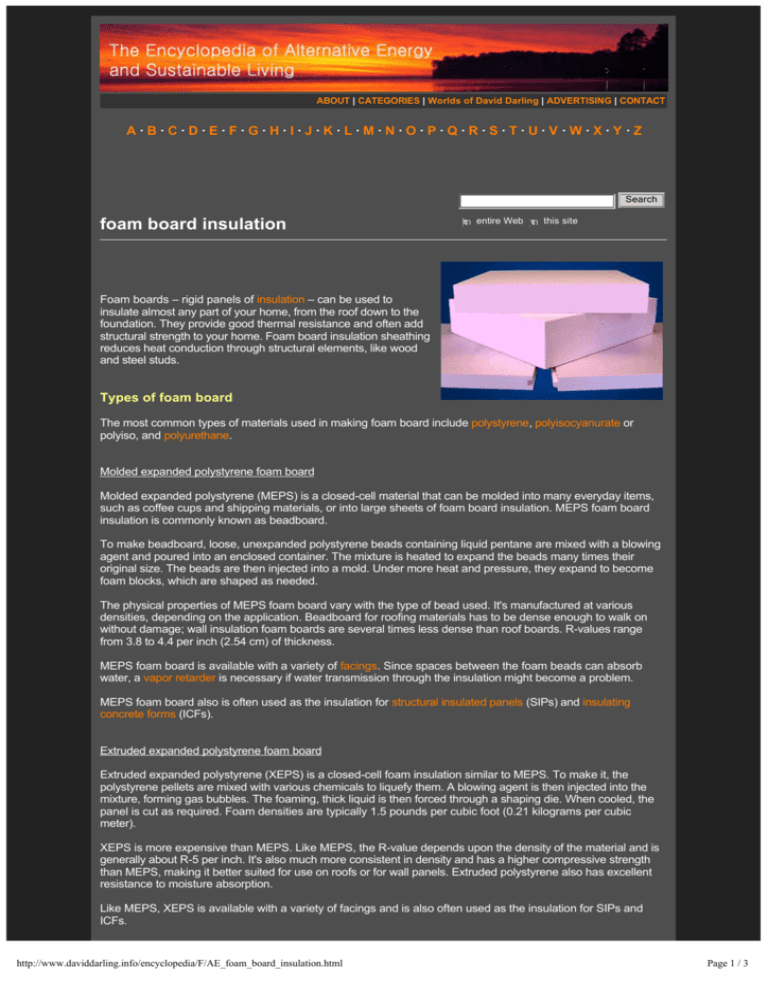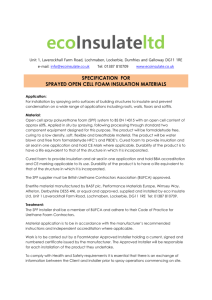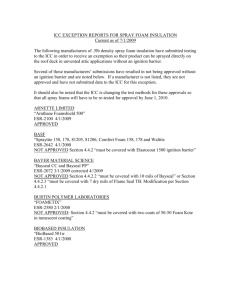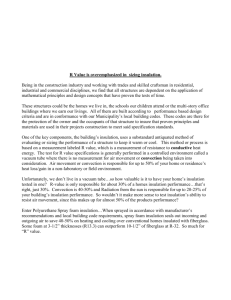foam board insulation - Paragon Home Inspection, LLC
advertisement

ABOUT | CATEGORIES | Worlds of David Darling | ADVERTISING | CONTACT A ∙ B ∙ C ∙ D ∙ E ∙ F ∙ G ∙ H ∙ I ∙ J ∙ K ∙ L ∙ M ∙ N ∙ O ∙ P ∙ Q ∙ R ∙ S ∙ T ∙ U ∙ V ∙ W ∙ X ∙ Y ∙ Z Search foam board insulation n j entire Web n k l m i this site j k l m Foam boards – rigid panels of insulation – can be used to insulate almost any part of your home, from the roof down to the foundation. They provide good thermal resistance and often add structural strength to your home. Foam board insulation sheathing reduces heat conduction through structural elements, like wood and steel studs. Types of foam board The most common types of materials used in making foam board include polystyrene, polyisocyanurate or polyiso, and polyurethane. Molded expanded polystyrene foam board Molded expanded polystyrene (MEPS) is a closed-cell material that can be molded into many everyday items, such as coffee cups and shipping materials, or into large sheets of foam board insulation. MEPS foam board insulation is commonly known as beadboard. To make beadboard, loose, unexpanded polystyrene beads containing liquid pentane are mixed with a blowing agent and poured into an enclosed container. The mixture is heated to expand the beads many times their original size. The beads are then injected into a mold. Under more heat and pressure, they expand to become foam blocks, which are shaped as needed. The physical properties of MEPS foam board vary with the type of bead used. It's manufactured at various densities, depending on the application. Beadboard for roofing materials has to be dense enough to walk on without damage; wall insulation foam boards are several times less dense than roof boards. R-values range from 3.8 to 4.4 per inch (2.54 cm) of thickness. MEPS foam board is available with a variety of facings. Since spaces between the foam beads can absorb water, a vapor retarder is necessary if water transmission through the insulation might become a problem. MEPS foam board also is often used as the insulation for structural insulated panels (SIPs) and insulating concrete forms (ICFs). Extruded expanded polystyrene foam board Extruded expanded polystyrene (XEPS) is a closed-cell foam insulation similar to MEPS. To make it, the polystyrene pellets are mixed with various chemicals to liquefy them. A blowing agent is then injected into the mixture, forming gas bubbles. The foaming, thick liquid is then forced through a shaping die. When cooled, the panel is cut as required. Foam densities are typically 1.5 pounds per cubic foot (0.21 kilograms per cubic meter). XEPS is more expensive than MEPS. Like MEPS, the R-value depends upon the density of the material and is generally about R-5 per inch. It's also much more consistent in density and has a higher compressive strength than MEPS, making it better suited for use on roofs or for wall panels. Extruded polystyrene also has excellent resistance to moisture absorption. Like MEPS, XEPS is available with a variety of facings and is also often used as the insulation for SIPs and ICFs. http://www.daviddarling.info/encyclopedia/F/AE_foam_board_insulation.html Page 1 / 3 Polyisocyanurate and polyurethane foam board Polyisocyanurate or polyiso and polyurethane are very similar, closed-cell foam insulation materials. Because both materials offer high R-values (R 5.6 to R 8) per inch of thickness, you can use a thinner foam board to achieve the required thermal resistance. This can be an advantage if you have space limitations. Polyiso foam board insulation is available in a variety of compressive strengths. Compressive strength refers to the ability of a rigid foam board to resist deformation and maintain its shape when subjected to a force or load. Also, polyiso remains stable over a wide temperature range (-100ºF to +250ºF). This makes it good as roofing insulation. And when used with a laminated aluminum foil facing, polyiso foam board provides an effective moisture or vapor barrier. These foam boards can also be used to make SIPs. Installation The maximum performance of foam board insulation depends heavily on proper installation. Therefore, it's best to have a certified insulation installer do it. If you'd like to have it installed professionally, you should do the following: l Obtain written cost estimates from several contractors for the R-value you need. Don't be surprised to find quoted prices for a given R-value installation to vary by more than a factor of two. l Ask contractors about their air-sealing services and costs as well, if needed. l To evaluate batt installation, you can measure batt thickness and check for gaps between batts. If you want to install it yourself, you should try to obtain instructions and safety precautions from the manufacturer. Carefully follow these instructions. You should also check your local building and fire codes. Avoiding direct sunlight damage Protect all types of foam insulation from direct sunlight. Over time, the sun's ultraviolet rays can damage the insulation. For roofs, this is generally done by applying a coating such as tar, acrylic, silicone, or rubberized paint. You can also cover the foam with a rubber or plastic membrane, or a layer of asphalt and roofing felt. Make certain you are using compatible products. The solvents in some coatings dissolve certain plastics. Avoiding potential moisture problems In cold weather, warm inside air containing water vapor can get past the wall finish and insulation, condensing inside the colder wall cavity. In hot, humid climates the same thing can happen, just in the reverse direction. Humid outdoor air in the summer can condense inside cool, air conditioned wall cavities. If enough of this happens and the water cannot escape, wood rot, mold, and other moisture-related problems can occur. For this reason, building codes often require installing a vapor diffusion retarder on the warmest side of the wall cavity. Foam board insulation is commonly placed between the exterior finish (i.e., siding, brick) and the studs of exterior walls. To prevent air infiltration, you should place rigid insulation boards tightly together and seal the seams with tape or caulk. However, this practice may worry some builders in cold climates since the foam board may act as a second vapor diffusion retarder. Studies have shown, however, that condensation rarely occurs in these areas unless something else is seriously wrong with the wall assembly (i.e., massive uncontrolled air leakage into the walls from the house). If the assembly is constructed correctly, the inside surface of the foam board stays warm enough to keep water vapor in its gaseous state long enough for it to escape. Avoiding potential insect problems When insulating a foundation you need to consider that, although insects don't eat foam board, they can easily tunnel through it. Insect burrows reduce the R-value and structural integrity of the insulation. For these reasons, some manufacturers treat their foam products with an insecticide, usually a borate compound. Many building jurisdictions also mandate treating the earth around the building with insecticides. These jurisdictions may also want an inspection area several inches wide and all around the foundation of a house kept bare of insulation board. A better solution for below-grade walls in need of insulation is to install the foam board over the interior of the basement walls rather than on the exterior, which is more common. Interior applications prevent ground-dwelling insects from finding the foam board at all, and they eliminate the need for the bare inspection area. Insulating interior walls, however, requires careful attention to moisture control. Most jurisdictions also require installing a fire barrier over the interior foam board. While this adds extra cost, the thermal performance of this method is superior in most cases to the more common exterior foam board application. This equates with a dollar savings in energy that can repay you many times over for the additional http://www.daviddarling.info/encyclopedia/F/AE_foam_board_insulation.html Page 2 / 3 cost of an interior application. If you plan to convert a basement into a living space, there is almost no additional cost. Ensuring fire protection Foam insulation is relatively hard to ignite, but when it is ignited, it burns readily and emits a dense smoke containing many toxic gases. The combustion characteristics of foam insulation products vary with the combustion temperatures, chemical formulation, and available air. Because of these characteristics, foams used for construction require a covering as a fire barrier. One half-inch thick (1.27 cm) gypsum wallboard is one of the most common fire barriers. Some building codes, however, do not require an additional fire barrier for certain metal-faced, laminated foam products. Check with your local building code/fire officials and insurers for specific information on what is permitted in your area. Related category • INSULATION TOPICS Source: US Department of Energy Also on this site: Encyclopedia of Science Encyclopedia of History BACK TO TOP http://www.daviddarling.info/encyclopedia/F/AE_foam_board_insulation.html Page 3 / 3







